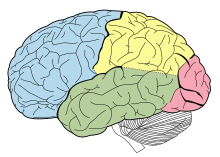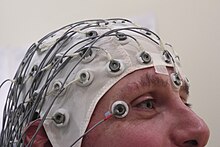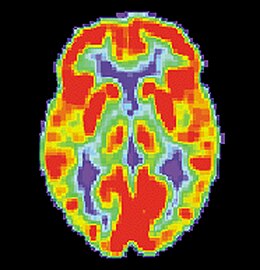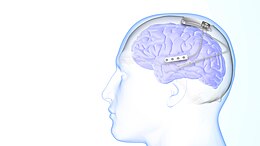Temporal lobe epilepsy
| Temporal lobe epilepsy | |
|---|---|
 | |
| Lobes of the brain. Temporal lobe in green | |
| Specialty | Neurology, Psychiatry |
In the field of neurology, temporal lobe epilepsy is an enduring brain disorder that causes unprovoked seizures from the temporal lobe. Temporal lobe epilepsy is the most common type of focal onset epilepsy among adults.[1] Seizure symptoms and behavior distinguish seizures arising from the medial temporal lobe from seizures arising from the lateral (neocortical) temporal lobe.[2] Memory and psychiatric comorbidities may occur. Diagnosis relies on electroencephalographic (EEG) and neuroimaging studies.[3][4] Anticonvulsant medications, epilepsy surgery and dietary treatments may improve seizure control.[5][6][6][7][8]
Types
[edit]Under the International League Against Epilepsy (ILAE) 2017 classification of the epilepsies, focal onset epilepsy occurs from seizures arising from a biological neural network within a single cerebral hemisphere.[9][10] Temporal lobe epilepsy occurs from seizures arising within the temporal lobe.[10] Temporal lobe epilepsy is the most common focal onset epilepsy, and 80% of temporal lobe epilepsy is mesial (medial) temporal lobe epilepsy, temporal lobe epilepsy arising from the inner (medial) part of the temporal lobe that may involve the hippocampus, parahippocampal gyrus or amygdala.[2][11] The less common lateral temporal lobe or neocortical temporal lobe seizures arise from the outer (lateral) temporal lobe.[2] The ILAE 2017 classification distinguishes focal aware from focal impaired seizures.[10] A focal aware temporal lobe seizure occurs if a person remains aware of what occurs during the entire seizure; awareness may be retained even if impaired responsiveness occurs during the seizure.[10] A focal impaired awareness temporal lobe seizure occurs if a person becomes unaware during any part of the seizure.[10]
Symptoms and behavior
[edit]Mesial temporal lobe epilepsy
[edit]During a temporal lobe seizure, a person may experience a seizure aura; an aura is an autonomic, cognitive, emotional or sensory experience that commonly occurs during the beginning part of a seizure.[10][2] The common medial temporal lobe seizure auras include a rising epigastric feeling, abdominal discomfort, taste (gustatory), smell (olfactory), tingling (somatosensory), fear, déjà vu, jamais vu, flushing, or rapid heart rate (tachycardia).[2] A person may then stare blankly, appear motionless (behavioral arrest) and lose awareness.[2] Repeated stereotyped motor behaviors (automatisms) may occur such as repeated swallowing, lip smacking, picking, fumbling, patting or vocalizations.[2] Dystonic posture is an unnatural stiffening of one arm occurring during a seizure.[12] A dystonic posture on one side of the body commonly indicates seizure onset from the opposite side of the brain e.g. right arm dystonic posture arising from a left temporal lobe seizure.[12] Impaired language function (dysphasia) during or soon following a seizure is more likely to occur when seizures arise from the language dominant side of the brain.[12]
Lateral temporal lobe epilepsy
[edit]The common auras from seizures arising from primary auditory cortex include vertigo, humming sound, ringing sound, buzzing sound, hearing a song, hearing voices or altered hearing sensation.[2] Lateral temporal lobe seizures arising from the temporal-parietal lobe junction may cause complex visual hallucinations.[2] In comparison to medial temporal lobe seizures, lateral temporal lobe seizures are briefer duration seizures, occur with earlier loss of awareness, and are more likely become a focal to bilateral tonic-clonic seizure.[2] Impaired language function (dysphasia) during or soon following a seizure is more likely to occur when seizures arise from the language dominant side of the brain.[12]
Comorbidities
[edit]Memory
[edit]The major cognitive impairment in mesial temporal lobe epilepsy is a progressive memory impairment.[13]: 71 This involves declarative memory impairment, including episodic memory and semantic memory, and is worse when medications fail to control seizures.[14][15][13]: 71 Mesial temporal lobe epilepsy arising from the language dominant hemisphere impairs verbal memory, and mesial temporal lobe epilepsy arising from the language non-dominant hemisphere impairs nonverbal memory.[13]: 71 [15]
Psychiatric comorbidities
[edit]Psychiatric disorders are more common among those with epilepsy, and the highest prevalence occurs among those with temporal lobe epilepsy.[16] The most common psychiatric comorbidity is major depressive disorder.[16] Other disorders include post-traumatic stress disorder, general anxiety disorder, psychosis, obsessive-compulsive disorder, schizophrenia, bipolar disorder, substance use disorder and a ~9% prevalence of suicide.[16]
Personality
[edit]Geschwind syndrome is a syndrome of altered sexuality (most often hyposexuality), religiosity, and compulsive or extensive writing and drawing occurring in persons with temporal lobe epilepsy.[17]: 347–348 However, subsequent studies did not support the association of these behavioral traits with temporal lobe epilepsy.[17]: 347–348 There are reports of religious behaviors occurring in persons with temporal lobe epilepsy.[18][19][20][21][22]
Causes
[edit]Hippocampal sclerosis, brain tumor, traumatic brain injury, cerebral vascular malformation, neuronal migration disorders, infections such as encephalitis and meningitis, autoimmune disease (limbic encephalitis) and genetic disorders may cause temporal lobe epilepsy.[23]
Risk factors
[edit]Many persons with uncontrolled temporal lobe epilepsy had childhood febrile seizures.[24] A brief febrile seizure only slightly increases the risk for developing afebrile seizures.[25] However, the prolonged seizure of febrile status epilepticus leads to a 9% risk for developing epilepsy.[25] There is no clear relationship between febrile seizures and development of hippocampal sclerosis.[25]
Mechanisms
[edit]



Neuronal loss
[edit]Hippocampal sclerosis occurs with severe CA1 and less severe CA3 and CA4 neuronal loss.[26] Experimental research has shown that N-methyl-d-aspartate (NMDA) receptor activation causes neuronal cell loss, and electrical stimulation-induced animal models of temporal lobe epilepsy duplicate the cell loss pattern of temporal lobe epilepsy in humans.[26] Repetitive seizures irreversibly damage interneurons leading to persistent loss of recurrent inhibition.[26] Damage of GABAergic interneurons lead to loss of inhibition, uncontrolled neuronal firing, leading to seizures.[26] The secondary epileptogenesis hypothesis is that repetitive seizures lead to interneuron loss, loss of glutamatergic principal neurons, axonal sprouting, and formation of new recurrent glutamatergic excitatory circuits leading to a more severe epilepsy.[27] Mechanisms related to neuronal loss incompletely account for temporal lobe epilepsy as temporal lobe epilepsy may occur with only minimal neuronal cell loss.[26]
Neuron-specific type 2 K+/Cl− cotransporter (KCC2) mutation
[edit]This KCC2 mutation prevents subicular neurons from potassium and chloride ion extrusion, leading to intracellular chloride accumulation, and positive γ-Aminobutyric acid (GABA) mediated currents.[26] Accumulated chloride efflux through GABA receptors leads to neuronal depolarization, increased neuronal excitability and ultimately seizures.[26] Persons with this mutation have mesial temporal lobe epilepsy with hippocampal sclerosis.[26]
Granule cell dispersion
[edit]Dentate gyrus granule cell dispersion refers to a granule cell layer that is widened, poorly demarcated, or accompanied by granule cells outside the layer (ectopic granule cells).[28]: 1318 In the normal brain, dentate granule cells block seizure spread from entorhinal cortex to the hippocampus.[26] A hypothesis is that granule cell dispersion may disrupt the normal mossy fiber pathway connecting granule cells and CA3 pyramidal cells leading to mossy fiber sprouting and new excitatory networks capable of generating seizures.[26] However, a study has shown that a similar pattern of granule cell dispersion may occur in persons without epilepsy.[29]
Cortical developmental malformations
[edit]Focal cortical dysplasia is a brain malformation that may cause temporal lobe epilepsy.[26] This malformation may cause abnormal cortical layers (dyslamination ), occur with abnormal neurons (dysmorphic neurons, balloon cells ) and may occur with a brain tumor or vascular malformation.[26] An abnormality of the MTOR pathway leads to hyperexcitable glutamate mediated neurons leading to seizures.[26]
Diagnosis
[edit]



Electroencephalogram
[edit]The temporal lobe epileptiform discharge is a pattern seen on the electroencephalgram (EEG) test; temporal lobe epileptiform discharges occur between seizures and confirm the diagnosis of temporal lobe epilepsy.[3] Long-term video-EEG monitoring may record the behavior and EEG during a seizure.[3] Magnetoencephalography may diagnose temporal lobe epilepsy by recording epileptiform discharges or seizure patterns arising from the magnetic fields of neural electrical currents.[3]
Neuroimaging
[edit]Neuroimaging tests may identify the cause for seizures and the seizure focus, the brain location where seizures begin.[4] In newly diagnosed epilepsy, magnetic resonance imaging (MRI) can detect brain lesion in up to 12 to 14% of persons with epilepsy.[30] However, for those with chronic epilepsy, MRI can detect brain lesion in 80% of the persons with epilepsy.[30] 3-Tesla MRI scan is advised for those with evidence of focal epilepsy such as temporal lobe epilepsy.[4] Abnormalities identified by MRI scan include hippocampal sclerosis, focal cortical dysplasia, other cortical developmental brain malformations, developmental and low-grade tumors, cavernous hemangioma, hypoxic-ischemic brain injury, traumatic brain injury and encephalitis.[4]
18F-fluorodeoxyglucose (18F-FDG) brain positron emission tomography (PET) may show a brain region of decreased glucose metabolism at a time between seizures; this hypometabolic region may correspond to the seizure focus, and PET scan is more sensitive for temporal lobe seizure focus localization compared to epilepsy arising from other brain lobes.[4] Single-photon emission computed tomography (SPECT) may show a region of decreased blood flow occurring 40-60 seconds after injection during the seizure; this reduced blood flow region may correspond to the seizure focus.[4]
Computed tomography (CT) scan is less sensitive than MRI scan for identifying small tumors, vascular malformations, cortical developmental brain malformations, and abnormalities in the medial temporal lobe.[30] CT scan is advised in emergencies when the suspected cause of epilepsy may be intracerebral hemorrhage, brain abscess, large cerebral infarction or subdural empyema.[4][30] A person who requires neuroimaging but cannot have an MRI scan due to implanted devices such as a cardiac pacemaker, defibrillator or cochlear implant may receive a CT scan. CT scan may better demonstrate calcium containing brain abnormalities causing epilepsy such as in tuberous sclerosis and Sturge–Weber syndrome.[4][30]
Treatment
[edit]Medical treatment
[edit]Anticonvulsant oral medications control seizures in about two-thirds of persons with epilepsy, and control commonly occurs with one or two medications.[31]
Surgical treatment
[edit]Those with uncontrolled seizures despite treatment with multiple anticonvulsant medications have pharmacoresistant epilepsy, and they may require epilepsy surgery to achieve seizure control.[9][31]
Penfield and Flanigan first described anterior temporal lobectomy, partial surgical removal of the temporal lobe, for treatment of mesial temporal lobe epilepsy in 1950.[32] In a prospective randomized controlled trial comparing anterior temporal lobectomy to medical therapy for pharmacoresistant temporal lobe epilepsy, surgery was more effective than medical therapy with 1-year seizure free outcome occurring in 58% of persons with anterior temporal lobectomy compared to 8% of persons with drug treatment.[5] Among those with intractable mesial temporal lobe epilepsy and hippocampal sclerosis, about 70% become seizure-free after epilepsy surgery.[33]: 751 Studies show that language dominant anterior temporal lobectomy may lead to verbal memory decline.[15] However, study outcomes are more variable on language non-dominant anterior temporal lobectomy leading to nonverbal memory decline.[15]
Magnetic resonance-guided laser interstitial thermal therapy, stereotactic radiosurgery, and stereotactic radiofrequency ablation are surgical methods that treat epilepsy by destroying the abnormal brain tissue that causes seizures.[34][35] [36]
Neurostimulation may also improve seizure control.[6] The vagus nerve stimulator (VNS) is surgically implanted in the chest, and delivers programmed electrical stimulation to the vagus nerve in the neck.[37] The responsive neurostimulation device is implanted in the skull, monitors electrical brain activity for seizures, and responds to seizures with programmed electrical stimulation to one or two brain areas.[38] Programmed deep brain stimulation of the anterior thalamic nucleus may treat seizures arising from more than 2 brain areas.[6]
Dietary treatment
[edit]The ketogenic diet and modified Atkins diet are additional temporal lobe epilepsy treatment options.[7][8]
Remission
[edit]Among those who develop childhood temporal lobe epilepsy, epilepsy remits in about one-third of children.[39] Remission was more likely among those without hippocampal sclerosis, brain tumor, or focal cortical dysplasia on MRI scan.[39]
See also
[edit]Notes
[edit]- ^ Muhlhofer et al. 2017.
- ^ a b c d e f g h i j Chowdhury et al. 2021.
- ^ a b c d Javidan 2012.
- ^ a b c d e f g h Duncan 2019.
- ^ a b Wiebe et al. 2001.
- ^ a b c d Touma et al. 2022.
- ^ a b Freeman, Kossoff & Hartman 2007.
- ^ a b Rezaei et al. 2019.
- ^ a b Scheffer et al. 2017.
- ^ a b c d e f Fisher et al. 2017.
- ^ Tatum 2012.
- ^ a b c d Rusu et al. 2005.
- ^ a b c Zeman, Kapur & Jones-Gotman 2012.
- ^ Quiroga 2012.
- ^ a b c d Bauman, Devinsky & Liu 2019.
- ^ a b c Lu et al. 2021.
- ^ a b David et al. 2012.
- ^ Tedrus et al. 2015.
- ^ d'Orsi & Tinuper 2006.
- ^ Sirven, Drazkowski & Noe 2007.
- ^ Arzy & Schurr 2016.
- ^ Tedrus, Fonseca & Höehr 2013.
- ^ Vadlamudi 2003.
- ^ Patterson, Baram & Shinnar 2014.
- ^ a b c Mewasingh, Chin & Scott 2020.
- ^ a b c d e f g h i j k l m Ong 2019.
- ^ Ben-Ari & Dudek 2010.
- ^ Blümcke et al. 2013.
- ^ Roy, Millen & Kapur 2020.
- ^ a b c d e Salmenpera & Duncan 2005.
- ^ a b Kwan & Brodie 2000.
- ^ Penfield & Flanigan 1950.
- ^ Lamberink et al. 2020.
- ^ Chen et al. 2023.
- ^ Kerezoudis et al. 2022.
- ^ Mustafa & Zaben 2022.
- ^ Goggins, Mitani & Tanaka 2022.
- ^ Geller 2018.
- ^ a b Spooner et al. 2006.
References
[edit]- Arzy, S; Schurr, R (2016). ""God has sent me to you":Right temporal epilepsy, left prefrontal psychosis". Epilepsy & Behavior. 60: 7–10. doi:10.1016/j.yebeh.2016.04.022. PMID 27176877. S2CID 3886939.
- Bauman, Kristie; Devinsky, Orrin; Liu, Anli A. (2019). "Temporal lobe surgery and memory: Lessons, risks, and opportunities". Epilepsy & Behavior. 101 (Pt A): 106596. doi:10.1016/j.yebeh.2019.106596. PMC 6885125. PMID 31711868.
- Ben-Ari, Yehezkel; Dudek, F. Edward (2010). "Primary and Secondary Mechanisms of Epileptogenesis in the Temporal Lobe: There is a before and an After". Epilepsy Currents. 10 (5): 118–125. doi:10.1111/j.1535-7511.2010.01376.x. ISSN 1535-7597. PMC 2951692. PMID 20944823.
- Blümcke, Ingmar; Thom, Maria; Aronica, Eleonora; Armstrong, Dawna D.; et al. (2013). "International consensus classification of hippocampal sclerosis in temporal lobe epilepsy: A Task Force report from the ILAE Commission on Diagnostic Methods". Epilepsia. 54 (7): 1315–1329. doi:10.1111/epi.12220. PMID 23692496. S2CID 37906434.
- Chen, Jia-Shu; Lamoureux, Audrey-Anne; Shlobin, Nathan A.; Elkaim, Lior M.; et al. (2023). "Magnetic Resonance-guided Laser Interstitial Thermal Therapy for Drug-Resistant Epilepsy: A Systematic Review and Individual Participant Data Meta-Analysis". Epilepsia. 64 (8): 1957–1974. doi:10.1111/epi.17560. ISSN 0013-9580. PMID 36824029. S2CID 257153269.
- Chowdhury, Fahmida A; Silva, Rui; Whatley, Benjamin; Walker, Matthew C (2021). "Localisation in focal epilepsy: a practical guide". Practical Neurology. 21 (6): 481–491. doi:10.1136/practneurol-2019-002341. PMID 34404748. S2CID 237156420.
- David, Daniel; Fleminger, Simon; Kopelman, Michael; Lovestone, Simon; Mellers, John (2012). Lishman's Organic Psychiatry: A Textbook of Neuropsychiatry. John Wiley & Sons. ISBN 978-0-470-67507-6.
- d'Orsi, Giuseppe; Tinuper, Paolo (2006). ""I heard voices*": from semiology, a historical review, and a new hypothesis on the presumed epilepsy of Joan of Arc". Epilepsy & Behavior. 9 (1): 152–157. doi:10.1016/j.yebeh.2006.04.020. PMID 16750938. S2CID 24961015.
- Duncan, John S. (2019). "Brain imaging in epilepsy". Practical Neurology. 19 (5): 438–443. doi:10.1136/practneurol-2018-002180. ISSN 1474-7758. PMID 31420416. S2CID 201041577.
- Fisher, RS; Cross, JH; French, JA; Higurashi, N; et al. (2017). "Operational classification of seizure types by the International League Against Epilepsy: Position Paper of the ILAE Commission for Classification and Terminology". Epilepsia. 58 (4): 522–530. doi:10.1111/epi.13670. hdl:11343/292620. PMID 28276060.
- Freeman, JM; Kossoff, EH; Hartman, AL (2007). "The ketogenic diet: one decade later". Pediatrics. 119 (3): 535–43. doi:10.1542/peds.2006-2447. PMID 17332207. S2CID 26629499.
- Geller, Eric B. (1 November 2018). "Responsive neurostimulation: Review of clinical trials and insights into focal epilepsy". Epilepsy & Behavior. 88: 11–20. doi:10.1016/j.yebeh.2018.06.042. ISSN 1525-5050. PMID 30243756. S2CID 52341485.
- Goggins, Eibhlin; Mitani, Shuhei; Tanaka, Shinji (2022). "Clinical perspectives on vagus nerve stimulation: present and future". Clinical Science. 136 (9): 695–709. doi:10.1042/CS20210507. PMC 9093220. PMID 35536161.
- Javidan, Manouchehr (2012). "Electroencephalography in Mesial Temporal Lobe Epilepsy: A Review". Epilepsy Research and Treatment. 2012: 1–17. doi:10.1155/2012/637430. PMC 3420622. PMID 22957235.
- Kerezoudis, Panagiotis; Tsayem, Idriss N.; Lundstrom, Brian N.; Van Gompel, Jamie J. (2022). "Systematic review and patient-level meta-analysis of radiofrequency ablation for medically refractory epilepsy: Implications for clinical practice and research". Seizure. 102: 113–119. doi:10.1016/j.seizure.2022.10.003. ISSN 1059-1311. PMID 36219914. S2CID 252690018.
- Kwan, P.; Brodie, M.J. (2000). "Early identification of refractory epilepsy". NEJM. 342 (5): 314–319. doi:10.1056/NEJM200002033420503. PMID 10660394.
- Lamberink, Herm J; Otte, Willem M; Blümcke, Ingmar; Braun, Kees P J; et al. (2020). "Seizure outcome and use of antiepileptic drugs after epilepsy surgery according to histopathological diagnosis: a retrospective multicentre cohort study". The Lancet Neurology. 19 (9): 748–757. doi:10.1016/S1474-4422(20)30220-9. PMID 32822635. S2CID 221162302.
- Lu, Elaine; Pyatka, Nataliya; Burant, Christopher J; Sajatovic, Martha (2021). "Systematic Literature Review of Psychiatric Comorbidities in Adults with Epilepsy". Journal of Clinical Neurology. 17 (2): 176–186. doi:10.3988/jcn.2021.17.2.176. PMC 8053555. PMID 33835737.
- Mewasingh, Leena D; Chin, Richard F M; Scott, Rod C (2020). "Current understanding of febrile seizures and their long-term outcomes". Developmental Medicine & Child Neurology. 62 (11): 1245–1249. doi:10.1111/dmcn.14642. PMID 32748466. S2CID 220966202.
- Muhlhofer, Wolfgang; Tan, Yee-Leng; Mueller, Susanne G.; Knowlton, Robert (2017). "MRI negative temporal lobe epilepsy—What do we know?". Epilepsia. 58 (5): 727–742. doi:10.1111/epi.13699. PMID 28266710. S2CID 10691471.
- Mustafa, Mohamed; Zaben, Malik (2022). "Minimal invasive brain surgery for epilepsy; can it be the future?". Journal of Neurology. 269 (11): 6178–6180. doi:10.1007/s00415-022-11360-z. ISSN 1432-1459. PMC 9553844. PMID 36098841.
- Ong, Leong Tung (2019). "Temporal Lobe Epilepsy – Pathophysiology and Mechanisms". European Neurological Review. 14 (2): 66. doi:10.17925/ENR.2019.14.2.66. S2CID 213850147.
- Patterson, Katelin P.; Baram, Tallie Z.; Shinnar, Shlomo (2014). "Origins of Temporal Lobe Epilepsy: Febrile Seizures and Febrile Status Epilepticus" (PDF). Neurotherapeutics. 11 (2): 242–250. doi:10.1007/s13311-014-0263-4. PMC 3996115. PMID 24604424.
- Penfield, Wilder; Flanigan, Herman (1950). "Surgical therapy of temporal lobe seizures". Archives of Neurology and Psychiatry. 64 (4): 491–500. doi:10.1001/archneurpsyc.1950.02310280003001. PMID 14770593.
- Quiroga, Rodrigo Quian (2012). "Concept cells:the building blocks of declarative memory functions". Nature Reviews Neuroscience. 13 (8): 587–597. doi:10.1038/nrn3251. PMID 22760181. S2CID 12802960.
- Rezaei, Shahabeddin; Abdurahman, Ahmed Abdulahi; Saghazadeh, Amene; Badv, Reza Shervin; Mahmoudi, Maryam (2019). "Short-term and long-term efficacy of classical ketogenic diet and modified Atkins diet in children and adolescents with epilepsy: A systematic review and meta-analysis". Nutritional Neuroscience. 22 (5): 317–334. doi:10.1080/1028415X.2017.1387721. PMID 29069983. S2CID 21117747.
- Roy, Achira; Millen, Kathleen J.; Kapur, Raj P. (2020). "Hippocampal granule cell dispersion: a non-specific finding in pediatric patients with no history of seizures". Acta Neuropathologica Communications. 8 (1): 54. doi:10.1186/s40478-020-00928-3. PMC 7171777. PMID 32317027.
- Rusu, V.; Chassoux, F.; Landre, E.; Bouilleret, V.; et al. (2005). "Dystonic posturing in seizures of mesial temporal origin: Electroclinical and metabolic patterns". Neurology. 65 (10): 1612–1619. doi:10.1212/01.wnl.0000184510.44808.50. PMID 16301490. S2CID 29551407.
- Salmenpera, T.M.; Duncan, J.S. (2005). "Imaging in epilepsy". Journal of Neurology, Neurosurgery & Psychiatry. 76 (suppl 3): iii2–iii10. doi:10.1136/jnnp.2005.075135. ISSN 0022-3050. PMC 1765703. PMID 16107387.
- Scheffer, Ingrid E.; Berkovic, Samuel; Capovilla, Giuseppe; Connolly, Mary B.; et al. (2017). "ILAE classification of the epilepsies: Position paper of the ILAE Commission for Classification and Terminology". Epilepsia. 58 (4): 512–521. doi:10.1111/epi.13709. PMC 5386840. PMID 28276062.
- Sirven, Joseph I; Drazkowski, Joseph F; Noe, Katherine H (2007). "Seizures among public figures: lessons learned from the epilepsy of Pope Pius IX". Mayo Clinic Proceedings. 82 (12): 1535–1540. doi:10.1016/S0025-6196(11)61100-2. PMID 18053463.
- Spooner, C.G.; Berkovic, S.F.; Mitchell, L.A.; Wrennall, J.A.; et al. (2006). "New-onset temporal lobe epilepsy in children: Lesion on MRI predicts poor seizure outcome". Neurology. 67 (12): 2147–2153. doi:10.1212/01.wnl.0000248189.93630.4f. PMID 17082466. S2CID 1238402.
- Tatum, William O. (2012). "Mesial Temporal Lobe Epilepsy". Journal of Clinical Neurophysiology. 29 (5): 356–365. doi:10.1097/WNP.0b013e31826b3ab7. PMID 23027091. S2CID 29616130.
- Tedrus, Glória Maria Almeida Souza; Fonseca, Lineu Corrêa; Höehr, Gabriela Chaves (2013). "Spirituality aspects in patients with epilepsy". Seizure. 23 (1): 25–8. doi:10.1016/j.seizure.2013.09.005. PMID 24094727.
- Tedrus, Glória Maria Almeida Souza; Fonseca, Lineu Corrêa; Fagundes, Tatiane Mariani; da Silva, Gabriela Leopoldino (2015). "Religiosity aspects in patients with epilepsy". Epilepsy & Behavior. 50: 67–70. doi:10.1016/j.yebeh.2015.06.003. PMID 26133113. S2CID 22703938.
- Touma, Lahoud; Dansereau, Bénédicte; Chan, Alvin Y.; Jetté, Nathalie; et al. (2022). "Neurostimulation in people with drug-resistant epilepsy: Systematic review and meta-analysis from the ILAE Surgical Therapies Commission". Epilepsia. 63 (6): 1314–1329. doi:10.1111/epi.17243. ISSN 1528-1167. PMID 35352349. S2CID 247792263.
- Vadlamudi, L (2003). "Genetics of temporal lobe epilepsy". Journal of Neurology, Neurosurgery & Psychiatry. 74 (10): 1359–1361. doi:10.1136/jnnp.74.10.1359. PMC 1757393. PMID 14570824.
- Wiebe, Samuel; Blume, Warren T.; Girvin, John P.; Eliasziw, Michael (2001). "A Randomized, Controlled Trial of Surgery for Temporal-Lobe Epilepsy". New England Journal of Medicine. 345 (5): 311–318. doi:10.1056/NEJM200108023450501. PMID 11484687. S2CID 31539171.
- Zeman, Adam; Kapur, Narinder; Jones-Gotman, Marilyn (2012). Epilepsy and memory (1. ed.). Oxford: Oxford Univ. Press. ISBN 978-0199580286.


 French
French Deutsch
Deutsch